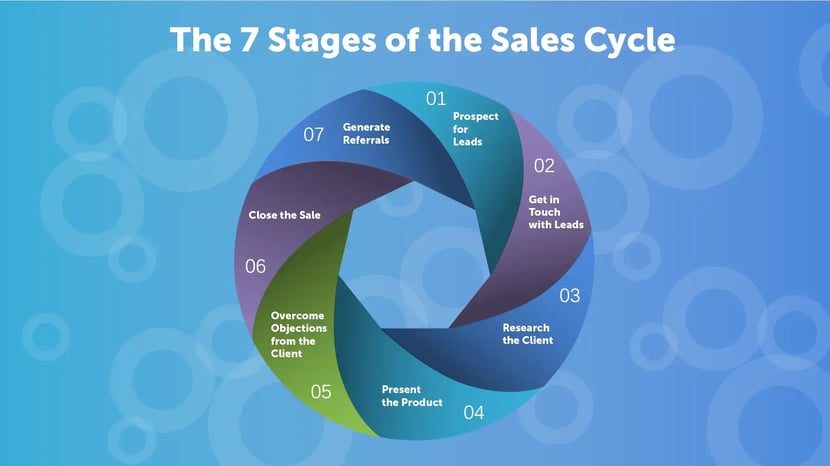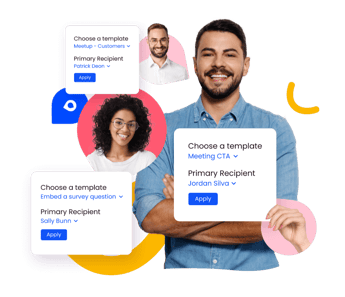- Solutions
-
Products
-
Resources
Sales Automation: What It Is, How It Works, and What to Automate First by Kristi Campbell View all Blog Posts >Get the App, Get the Sidebar, & Get Your Trial Going HereUnleash limitless growth opportunities by partnering with Cirrus Insight.
- Pricing
Filter By:
- All topics
- Sales Intelligence
- Salesforce
- Sales Productivity
- Sales Strategy
- Sales Prospecting
- Book More Meetings
- Sales Activity Data
- Company News
- Sales Leadership
- Sales Metrics
- Team Scheduling
- Prospect Smarter
- AI
- Serious Insights
- Comparison
- Conversation Intelligence
- Sync To Your CRM
- Email Blast
- Email Campaigns
7 Sales Cycle Stages to Boost Strategies & Revenue

Today, we’ll be discussing how you can use the concept of the sales process to optimize the way you sell your product, and hopefully, improve your selling rate too.
What You'll Learn:
- What is a sales cycle?
- Why is the sales cycle so important?
- Tools & techniques to optimize the sales cycle
- Sales cycle best practices
- Sales cycle stages vs sales cycle steps
- How to streamline your sales cycle management
What Is a Sales Cycle?
A sales cycle is the process representatives follow to convert prospects and leads into paid customers. Generally, the sales cycle comprises of seven steps, starting with product discovery and ending with the final sale. The sales cycle is also referred to as the sales funnel, sales process, and buyer's journey.
How Mastering the Sales Cycle Stages Will Help You
A good sales cycle should include several distinct stages. Defining the sales funnel stages will help your team pinpoint which parts of the buyer’s journey are working and which parts need improvement.
Understanding the sales funnel stages will also help you discover how your company can guide the client through a smooth transaction. The fewer hiccups along the way, the smaller the chance your client will back out of the sale.
Why is the Sales Cycle so Important
The sales cycle is a critical component of overall business success, directly impacting conversion rates, revenue predictability, and long-term profitability. A well-structured sales cycle provides a clear roadmap for guiding prospects from initial interest to final purchase, ensuring a streamlined and efficient process. Research shows that companies with a defined sales cycle experience 18% higher revenue growth compared to those without one. By analyzing each stage businesses can identify bottlenecks, optimize sales strategies, and improve win rates. For example, implementing AI-driven sales forecasting tools can increase forecast accuracy by 30-50%, enabling better resource allocation and quota management.
A refined sales cycle enhances customer relationships and retention. Businesses that effectively nurture leads throughout the cycle see 50% more sales-ready leads at a 33% lower cost than those that don’t. Take Salesforce, for instance—by leveraging data-driven insights and automation, they significantly shortened their sales cycle while boosting close rates. Similarly, B2B companies that align their sales and marketing efforts around a structured sales process achieve 38% higher sales win rates.
Ultimately, refining the sales cycle isn’t just about closing deals faster—it’s about driving sustainable revenue growth, improving customer experience, and ensuring long-term profitability in increasingly competitive markets.
Sales Cycle Optimization: Tools & Techniques
Optimizing the sales cycle requires a strategic approach that integrates the right tools and techniques to enhance efficiency, improve conversion rates, and drive revenue growth. By leveraging AI, automation, and sales analytics, businesses can streamline their sales processes and maximize results. Below are some of the most effective tools and techniques for optimizing the sales cycle:
AI-Powered Lead Scoring & Prospecting
AI-driven lead scoring tools analyze prospect behavior, engagement levels, and firmographic data to identify high-potential leads. Solutions like HubSpot, 6sense, and Gong help sales teams focus on the most promising opportunities, increasing conversion rates.
Sales Automation Platforms
Automating repetitive tasks such as follow-ups, email sequences, and data entry frees up valuable time for sales reps to focus on high-value interactions. Tools like Outreach, Salesloft, and Cirrus Insight help shorten the sales cycle by ensuring timely and consistent engagement with prospects.
Automated Scheduling & Meeting Management
Reducing friction in the scheduling process leads to faster deal progression. Tools like Cirrus Insight’s Smart Scheduler, Calendly, and Chili Piper eliminate back-and-forth emails by allowing prospects to book meetings instantly.
Sales Enablement & Content Management
Providing sales reps with the right content at the right time improves engagement and conversion rates. Platforms like Seismic, Highspot, and Showpad offer AI-powered content recommendations, boosting sales effectiveness.
By integrating these tools and techniques, sales teams can optimize their workflows, reduce cycle time, and increase revenue efficiency. A data-driven approach ensures continuous improvement, empowering sales organizations to stay competitive in an evolving market.
Best Sales Cycle Practices
Optimizing the sales cycle is crucial for maximizing efficiency, improving conversion rates, and driving revenue growth. By implementing best practices, sales teams can streamline their approach, shorten deal timelines, and increase win rates. Below are some of the most effective sales cycle practices:
1. Leverage Data-Driven Prospecting
Successful sales cycles start with targeting the right prospects. Sales teams that use AI-powered prospecting tools and predictive analytics can identify high-intent leads faster, and increase conversion rates. For instance, companies using LinkedIn Sales Navigator have reported a 20% increase in sales opportunities due to better targeting.
2. Personalize Sales Pitches with Buyer Insights
Generic sales pitches don’t resonate with modern buyers. High-performing sales teams leverage CRM data, AI insights, and real-time analytics to tailor their messaging. Meeting AI, by Cirrus Insight, provides sales reps with automated research allowing them to personalize their pitch—increasing deal closure likelihood.
3. Automate Follow-Ups and Nurturing
Timely follow-ups are critical to keeping prospects engaged. Sales automation tools like Email Blast and Buyer Signals reduce manual effort, ensuring consistent communication. Businesses using automated email sequences see a 451% increase in qualified leads, while persistent follow-up strategies can boost conversion rates even more.
4. Shorten the Sales Cycle with Efficient Demos & Trials
Offering immediate value through demos and free trials accelerates decision-making. Companies that provide on-demand product demos tend to have faster sales cycle compared to those requiring scheduled walkthroughs. For example, SaaS companies like Zoom and Dropbox have mastered this strategy, allowing prospects to experience value instantly.
5. Align Sales and Marketing for a Seamless Journey
Sales and marketing alignment leads to higher-quality leads and smoother conversions. Companies that integrate their CRM with marketing automation platforms generate more revenue and close deals faster than those with siloed teams.
By incorporating these best practices, sales teams can create a more efficient and results-driven sales cycle, ultimately boosting revenue and long-term customer relationships.
Sales Cycle Stages vs Sales Cycle Steps
The terms "Sales Cycle Stages" and "Sales Cycle Steps" are often used interchangeably, but they serve distinct roles in the sales process.
Sales Cycle Stages represent the broad phases a prospect moves through on their journey from lead to customer. These typically include Prospecting, Qualification, Engagement, Proposal, Negotiation, and Closing. Each stage reflects a key milestone in the sales funnel, providing a high-level view of where a deal stands.
On the other hand, Sales Cycle Steps are the specific actions sales reps take within each stage to move the deal forward. These are tactical and execution-focused, guiding reps on what to do at each phase.
The 7 Sales Cycle Stages Explained
A well-structured sales cycle is essential for improving efficiency, increasing conversion rates, and driving predictable revenue. At Cirrus Insight, we help sales teams streamline their workflows and maximize productivity throughout all seven stages of the sales cycle:
Pre-Qualification
Before engaging with a lead, it’s crucial to determine whether your solution aligns with their challenges. Sales teams need to quickly assess fit and prioritize high-quality prospects.
Discovery
Understanding a prospect’s business, pain points, and key stakeholders is critical. Sales reps should be seamlessly booking discovery calls and capturing all interactions directly within their CRM.
Working
Sales reps need to demonstrate a deep understanding of a prospect’s challenges and offer tailored solutions. With Meeting AI, Cirrus Insight equips reps with real-time insights to craft personalized pitches that resonate with decision-makers.
Proposal
Once a solution is outlined, it’s time to present the business impact in a compelling way. Automated follow-ups and document tracking ensure that proposals don’t get lost in a crowded inbox and that reps know exactly when a prospect engages with their materials.
Negotiation
Gaining approval and alignment often requires multiple touchpoints—with real-time email tracking and follow-up automation, ensure no opportunity falls through the cracks.
Deal Review
Before finalizing a deal, internal approvals and logistics must be aligned. By integrating with Salesforce and other tools, you can be confident that that all deal-related communications, contracts, and next steps are easily accessible for a smooth closing process.
Closed-Won
Securing the deal is just the beginning. Sales teams can automate post-sale follow-ups, nurture relationships, and identify upsell opportunities, setting the stage for long-term success.
By leveraging Cirrus Insight’s suite of automation tools, AI-driven research, and seamless CRM integration, sales teams can accelerate their sales cycle and close more deals with greater efficiency.

The 7 Sales Cycle Steps Explained
Most sales professionals agree that the buyer’s journey should typically consist of seven stages.
1. Prospect New Leads
The first stage of any sales cycle is to seek out prospects. After all, you’ll never make a sale along the buyer’s journey without someone who wants to buy your product.
Prospecting new leads can involve a wide range of tactics:
- Meeting people at live industry events
- Social media-based prospecting
- Researching potential clients on websites like LinkedIn or Quora
- Taking referrals from current customers
Lead generation can prove to be a deceptively difficult stage. According to HubSpot, over 40% of salespeople claim it is the hardest of the sales process steps.
Because these sales funnel stage is notoriously difficult, it’s important to spend time developing a diverse prospecting system that works within your industry.
2. Get in Touch With Leads
Once your sales team has gone through the lead generation process, the next stage is for each sales rep to start making first contact with potential new customers.
Contacting leads can be done via:
- Automation: Automate the contact stage by sending sales pitches using cold email templates.
- Cold calling: Sales reps contact leads through a phone call or email with an enticing sales pitch.
- Warm Leads: Sales reps contact leads through a personalized phone call or email addressing their request.
A qualified lead is a lead that fits your business’s buyer persona or ideal customer profile. In other words, sales reps should use this first contact as a chance to ask qualifying questions to determine if the potential new customer is a good fit. These questions can include:
- What problem is your business trying to solve?
- What is your role in the company?
- When do you need a solution by?
- What other solutions is the company considering?
Persistence is key during this stage. According to The Brevet Group, 80% of sales take five follow-up calls.
3. Research the Client
Once a client has been contacted, the sales team should conduct extensive research on the prospect. During this sales funnel stage, you will get the chance to tailor your sales pitch to each individual prospect and improve your chances of closing a deal.
During the research stage, make it a priority to understand what each prospect needs from your service. What are their main challenges? How will your service slot into the overall business? What can the business expect from implementing your product?
4. Present the Product
In the next stage, your sales team will formally present the product to the interested client. This formal sales pitch is a key stage that usually comes after you have determined that a lead is a serious prospect and that your product is the right fit for their business.
After the research stage, you should already have an in-depth understanding of this prospect’s challenges, goals, and pain points. Your presentation should hone in on how your product provides a unique answer to these specifics.
5. Overcome Any Objections From the Client
After a formal presentation, your potential client will consider your product carefully. It’s common for prospects to have questions and concerns at this stage. It’s extremely rare that a sales pitch seals the deal without facing any initial objections.
That’s why overcoming objections is often included as one of the necessary steps in the sales process.
So, when the decision-maker at the company raises their concerns following the presentation, your sales team should be prepared to answer them. When you use your research state to prepare for possible common objections, you’ll find these sales funnel stage much simpler and smoother.
6. Close the Sale
After overcoming any possible objections to your sales pitch, it’s time to close the deal and turn your prospect into a new customer. Depending on your company, this stage can involve delivering a quote, finalizing negotiations, signing a contract, or simply exchanging your product.
7. Generate Referrals
The sales cycle is, unsurprisingly, cyclical in nature. This means that once you close deals and reach the end of the selling process, you return to the beginning and start seeking out new leads once again.
Sales reps should stay in contact with clients after the buyer’s journey and making a sale. With a timely follow-up, sales reps have the opportunity to upsell current customers, or find new potential customers by generating referrals.
According to IDC, 73% of executives prefer working with sales reps who are referred to them by someone they know, so the importance of this sales funnel stage can’t be overstated.
Streamline Your Sales Cycle Management with Cirrus Insight
By refining your sales workflow using the stages of the sales cycle, you’ll help your sales managers close deals and improve your sales conversion rate. Each stage requires time and expertise in order to make the sales pipeline run smoothly and effectively.
Cirrus Insight specializes in optimizing your Salesforce-based sales cycle management. We make the defined sales cycle easy to follow by helping you buyer signals, schedule meetings, arrange follow-up appointments — all from your inbox. With Cirrus Insight, you can also set up automated emails to send to customers that might be blocked by an objection, or stuck in a part of the sales funnel.
Start a 14 Day Free Trial or schedule a demo to transform your sales process today.
Frequently Asked Questions (FAQs)
How does the sales cycle impact overall business growth?
The sales cycle directly influences revenue, customer acquisition, and long-term profitability. A well-optimized sales cycle improves conversion rates, shortens deal timelines, and enhances customer relationships, leading to sustainable growth.How long does a typical sales cycle last?
The length of a sales cycle varies by industry, product complexity, and customer type. B2B sales cycles can take 3 to 12 months due to multiple decision-makers and approval processes.
B2C sales cycles are usually much shorter, often lasting minutes to a few weeks depending on the product and buying urgency.
How does an optimized sales cycle accelerate business growth?
Automation, AI-driven insights, and streamlined workflows reduce inefficiencies, allowing sales teams to close deals faster. Shortening the sales cycle means higher revenue velocity—more deals closed in less time.What is sales cycle management?
Sales cycle management involves tracking, analyzing, and optimizing each stage of the sales process. It ensures sales reps follow best practices, identify bottlenecks, and use data to improve efficiency.Build a Cadence to Nurture your Relationships
Send a sequence of pre-scheduled actions to prospects and customers.


.png?width=1268&height=1772&name=Sidebar-C%20(1).png)


